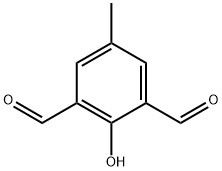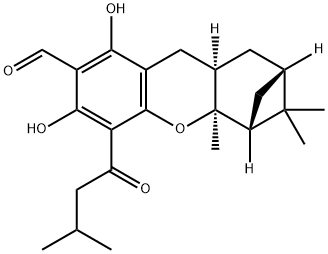2-HYDROXY-5-METHYLISOPHTHALALDEHYDE
- CAS NO.:7310-95-4
- Empirical Formula: C9H8O3
- Molecular Weight: 164.16
- MDL number: MFCD00016596
- EINECS: 230-768-4
- SAFETY DATA SHEET (SDS)
- Update Date: 2023-04-23 13:52:06

What is 2-HYDROXY-5-METHYLISOPHTHALALDEHYDE?
Chemical properties
light yellow to beige cryst. powder or needles
The Uses of 2-HYDROXY-5-METHYLISOPHTHALALDEHYDE
2-Hydroxy-5-methyl-1,3-benzenedicarboxaldehyde (2-hydroxy-5-methylisophthalaldehyde) is suitable reagent used in the synthesis of 2-(2′-vinyloxyethoxy)-5-methylisophthaldehyde and chiral calixsalen macrocycles.
2-Hydroxy-5-methyl-1,3-benzenedicarboxaldehyde may be used in the synthesis of the following:
- 3-[(2,4-Dichlorophenyl)iminomethyl]-2-hydroxy-5-methylbenzaldehyde, a Schiff base.
- 2-Hydroxy-3-methoxymethyl-5-methylbenzaldehyde.
- Acyclic Schiff-base ligands.
- Macrobicyclic ligands (MSB).
- 4-Methyl-2,6-divinylphenol.
- 2-Hydroxy-3-dimethoxymethyl-5-methylbenzaldehyde.
General Description
2-Hydroxy-5-methyl-1,3-benzenedicarboxaldehyde (2-hydroxy-5-methylisophthalaldehyde) is a dialdehyde derivative. It has been synthesized by heating p-cresol with hexamethylenetetramine. The structure has been confirmed by 1H and 13C NMR. It is an important raw material for the synthesis of various binucleating schiff base ligand.
Properties of 2-HYDROXY-5-METHYLISOPHTHALALDEHYDE
| Melting point: | 128-130 °C (lit.) |
| Boiling point: | 251.61°C (rough estimate) |
| Density | 1.2132 (rough estimate) |
| refractive index | 1.5380 (estimate) |
| storage temp. | Keep in dark place,Sealed in dry,Room Temperature |
| pka | 6.69±0.23(Predicted) |
| form | powder to crystal |
| color | White to Yellow to Orange |
| CAS DataBase Reference | 7310-95-4(CAS DataBase Reference) |
Safety information for 2-HYDROXY-5-METHYLISOPHTHALALDEHYDE
| Signal word | Warning |
| Pictogram(s) |
 Exclamation Mark Irritant GHS07 |
| GHS Hazard Statements |
H315:Skin corrosion/irritation H319:Serious eye damage/eye irritation H335:Specific target organ toxicity, single exposure;Respiratory tract irritation |
| Precautionary Statement Codes |
P261:Avoid breathing dust/fume/gas/mist/vapours/spray. P264:Wash hands thoroughly after handling. P264:Wash skin thouroughly after handling. P271:Use only outdoors or in a well-ventilated area. P280:Wear protective gloves/protective clothing/eye protection/face protection. P302+P352:IF ON SKIN: wash with plenty of soap and water. P305+P351+P338:IF IN EYES: Rinse cautiously with water for several minutes. Remove contact lenses, if present and easy to do. Continuerinsing. |
Computed Descriptors for 2-HYDROXY-5-METHYLISOPHTHALALDEHYDE
New Products
4-Fluorophenylacetic acid 4-Methylphenylacetic acid N-Boc-D-alaninol N-BOC-D/L-ALANINOL Tert-butyl bis(2-chloroethyl)carbamate 3-Morpholino-1-(4-nitrophenyl)-5,6-dihydropyridin- 2(1H)-one Furan-2,5-Dicarboxylic Acid Tropic acid S-2-CHLORO PROPIONIC ACID ETHYL ISOCYANOACETATE 2-Bromo-1,3-Bis(Dimethylamino)Trimethinium Hexafluorophosphate (6-METHYL-[1,3]DITHIOLO[4,5-b]QUINOXALIN-2-ONE INDAZOLE-3-CARBOXYLIC ACID 4-IODO BENZOIC ACID (2-Hydroxyphenyl)acetonitrile 4-Bromopyrazole 5,6-Dimethoxyindanone 2-(Cyanocyclohexyl)acetic acid 4-methoxy-3,5-dinitropyridine 2-aminopropyl benzoate hydrochloride 1-(4-(aminomethyl)benzyl)urea hydrochloride diethyl 2-(2-((tertbutoxycarbonyl)amino) ethyl)malonate tert-butyl 4- (ureidomethyl)benzylcarbamate Ethyl-2-chloro((4-methoxyphenyl)hydrazono)acetateRelated products of tetrahydrofuran








You may like
-
 2-Hydroxy-5-methylisophthalaldehyde CAS 7310-95-4View Details
2-Hydroxy-5-methylisophthalaldehyde CAS 7310-95-4View Details
7310-95-4 -
 2033-24-1 98%View Details
2033-24-1 98%View Details
2033-24-1 -
 1975-50-4 98%View Details
1975-50-4 98%View Details
1975-50-4 -
 2-HYDROXY BENZYL ALCOHOL 98%View Details
2-HYDROXY BENZYL ALCOHOL 98%View Details
90-01-7 -
 2-Chloro-1,3-Bis(Dimethylamino)Trimethinium Hexafluorophosphate 221615-75-4 98%View Details
2-Chloro-1,3-Bis(Dimethylamino)Trimethinium Hexafluorophosphate 221615-75-4 98%View Details
221615-75-4 -
 61397-56-6 CIS BROMO BENZOATE 98%View Details
61397-56-6 CIS BROMO BENZOATE 98%View Details
61397-56-6 -
 14714-50-2 (2-Hydroxyphenyl)acetonitrile 98+View Details
14714-50-2 (2-Hydroxyphenyl)acetonitrile 98+View Details
14714-50-2 -
 118753-70-1 98+View Details
118753-70-1 98+View Details
118753-70-1
Statement: All products displayed on this website are only used for non medical purposes such as industrial applications or scientific research, and cannot be used for clinical diagnosis or treatment of humans or animals. They are not medicinal or edible.